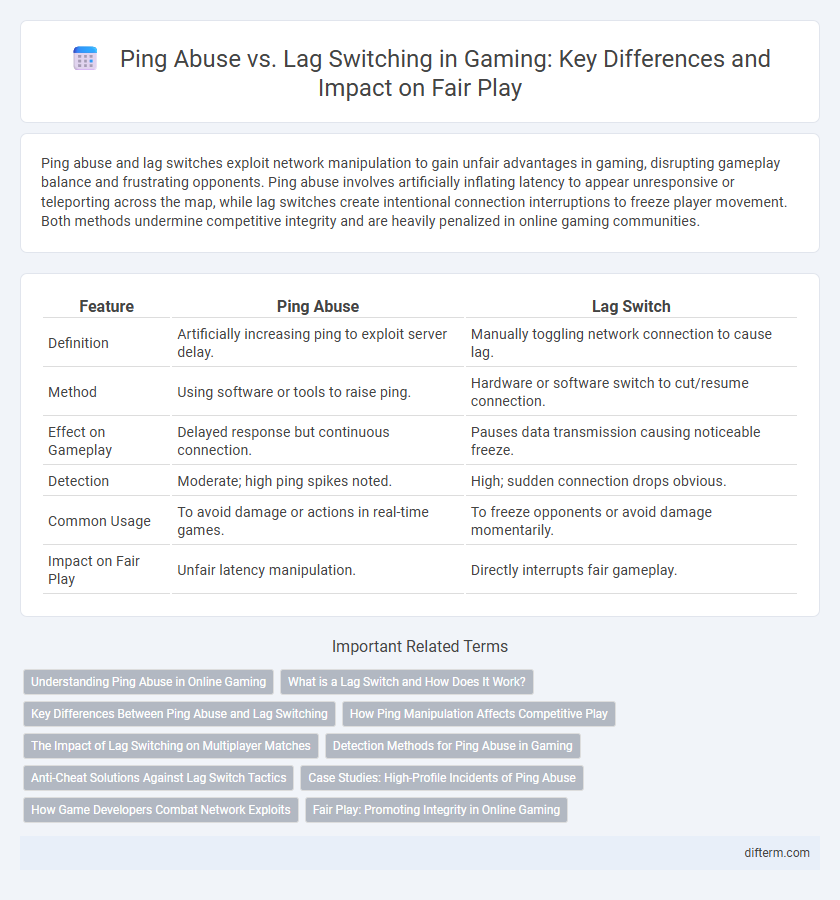Ping abuse and lag switches exploit network manipulation to gain unfair advantages in gaming, disrupting gameplay balance and frustrating opponents. Ping abuse involves artificially inflating latency to appear unresponsive or teleporting across the map, while lag switches create intentional connection interruptions to freeze player movement. Both methods undermine competitive integrity and are heavily penalized in online gaming communities.
Table of Comparison
| Feature | Ping Abuse | Lag Switch |
|---|---|---|
| Definition | Artificially increasing ping to exploit server delay. | Manually toggling network connection to cause lag. |
| Method | Using software or tools to raise ping. | Hardware or software switch to cut/resume connection. |
| Effect on Gameplay | Delayed response but continuous connection. | Pauses data transmission causing noticeable freeze. |
| Detection | Moderate; high ping spikes noted. | High; sudden connection drops obvious. |
| Common Usage | To avoid damage or actions in real-time games. | To freeze opponents or avoid damage momentarily. |
| Impact on Fair Play | Unfair latency manipulation. | Directly interrupts fair gameplay. |
Understanding Ping Abuse in Online Gaming
Ping abuse in online gaming involves manipulating latency to gain an unfair advantage, often by artificially increasing or stabilizing ping to disrupt opponents' gameplay. Unlike lag switches that abruptly cut a connection to freeze action, ping abuse exploits network characteristics to create inconsistent player experiences without obvious interruptions. Recognizing and addressing ping abuse is crucial for maintaining fair competition and server integrity in multiplayer environments.
What is a Lag Switch and How Does It Work?
A lag switch is a hardware or software device used by gamers to intentionally disrupt their internet connection, causing temporary lag in online gameplay. By creating artificial delays, the lag switch manipulates data packets between the player's console or PC and the game server, resulting in momentary freezing or rubberbanding effects. This tactic gives an unfair advantage by allowing the user to avoid attacks or reposition without detection during the disrupted connection period.
Key Differences Between Ping Abuse and Lag Switching
Ping abuse manipulates latency to gain an unfair advantage by artificially increasing or stabilizing ping to disrupt other players' gameplay, while lag switching actively interrupts data packets to create intentional spikes and delays. Ping abuse often exploits network settings or third-party tools to maintain consistent high ping, whereas lag switching involves physically or digitally toggling connectivity on and off to cause sudden lag. The key difference lies in the method: ping abuse subtly adjusts latency without complete disconnection, whereas lag switching causes abrupt, obvious disruptions in real-time data transmission.
How Ping Manipulation Affects Competitive Play
Ping manipulation, including ping abuse and lag switching, disrupts fair competition by creating artificial latency that hinders opponents' reaction time and movement accuracy. These tactics exploit network vulnerabilities to gain unfair advantages, such as dodging attacks or freezing gameplay, undermining the integrity of esports matches. Consistent ping manipulation erodes player trust and can lead to penalties or bans from competitive platforms striving to maintain balanced and skill-based environments.
The Impact of Lag Switching on Multiplayer Matches
Lag switching disrupts multiplayer matches by creating artificial latency spikes, allowing players to gain unfair advantages through sudden freezes or teleportation. This manipulation distorts game synchronization, causing frustration, mistrust, and imbalance among participants. Such exploitative behavior undermines competitive integrity and degrades the overall gaming experience in online environments.
Detection Methods for Ping Abuse in Gaming
Ping abuse detection in gaming relies on monitoring network traffic patterns and latency fluctuations to identify abnormal spikes that indicate manipulation. Advanced algorithms analyze player connection consistency, irregular packet loss, and sudden latency changes to differentiate between natural lag and intentional ping manipulation. Server-side tools also compare timestamps and sequence data from player inputs to detect discrepancies signaling ping abuse, ensuring fair gameplay.
Anti-Cheat Solutions Against Lag Switch Tactics
Anti-cheat solutions targeting lag switch tactics utilize real-time network monitoring to detect sudden packet delays or disruptions indicative of intentional latency manipulation. Machine learning algorithms analyze gameplay data patterns to distinguish genuine connectivity issues from lag switch abuse, enabling automated enforcement actions such as temporary bans or matchmaking restrictions. Integrating hardware-level latency detection further enhances accuracy, reducing false positives and maintaining fair play in competitive gaming environments.
Case Studies: High-Profile Incidents of Ping Abuse
High-profile incidents of ping abuse significantly impacted competitive gaming, with cases like a professional CS:GO player receiving a ban for manipulating latency to gain unfair advantages. Such abuse distorts gameplay integrity by artificially inflating ping, leading to delayed opponent responses and shattered match fairness. Game developers continuously monitor server logs and implement advanced detection algorithms to curb ping abuse and protect the esports ecosystem.
How Game Developers Combat Network Exploits
Game developers deploy sophisticated server-side algorithms to detect irregular packet timing and latency patterns indicative of ping abuse or lag switch exploitation. By implementing real-time monitoring tools combined with machine learning models, they differentiate between genuine connection issues and deliberate delays. Network-level countermeasures, such as adaptive timeout thresholds and synchronized state validation, minimize unfair advantages caused by manipulated latency.
Fair Play: Promoting Integrity in Online Gaming
Ping abuse and lag switches undermine fair play by exploiting network latency to gain unfair advantages in online gaming, disrupting balanced competition. Effective detection methods and strict enforcement of anti-cheat policies are crucial to maintaining integrity and ensuring an equitable gaming environment. Promoting awareness among players and developers helps foster a culture of honesty and respect in multiplayer communities.
Ping Abuse vs Lag Switch Infographic

 difterm.com
difterm.com